
Some arches, most of them monumental:

Babylonia, The Ishtar-Gate of Babylon, 6th century BCE,
glazed brick construction.
Near-Eastern Museum, Berlin. It was Babylonia's King Nebuchadnessar
II who captured (597) and destroyed (588) Jerusalem and carried
the Israelites into captivity in Babylon. See relief.

Roman, Pont du Gard Aqueduct, near Nimes, France,
c. 20-10 BCE.
See aqueduct and Roman art.

Roman
Colosseum, or Flavian Amphitheater, 70-82 CE,
a vast ellipse with tiers of seating for 50,000
spectators around a central elliptical arena. The façade
of three tiers of arches and an attic story is about 48.5 m (158
feet) tall. The three tiers of arcades
are faced by three-quarter columns
and entablatures, Doric in the first story,
Ionic in the second,
and Corinthian in the
third. The construction utilized a careful combination of types:
concrete for the foundations,
travertine for the piers and arcades, tufa
infill between piers for the walls of the lower two levels, and
brick-faced concrete used for the upper levels and for most of
the vaults.
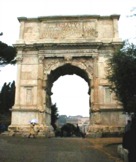
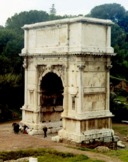
Arch
of Titus, in the Forum of Rome, built in 81 CE
to commemorate the capture
of Jerusalem. Although massive,
it was well proportioned
in order to minimize its weight.
The Arch of Titus is located the eastern edge of the forum and was used as one
of its principal entrances. In ancient times, soldiers returning
from victories in war or battle marched ceremoniously through
this arch and through the forum
to the cheers of the populace. The arch is carved
with relief sculptures
of the victory in Jeruselum. One
of them shows a parade in which the victors carry spoils from
the Temple.
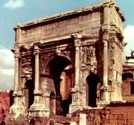
Roman, in the Forum of Rome, Arch of Septimius Severus, 203 CE,
bearing masonry. Another
classic example of a triumphal arch. Another view, including much of the Roman
Forum around the arch.

John Sell Cotman (English, 1782-1842), Crypt in the Church of St. Gervais, Rouen,
1819, pencil and wash on paper,
18.4 x 27.6 cm, Tate Gallery, London. See crypt.

John Nash (English, 1752-1835), Marble Arch, 1828, Oxford Street, London.
The Marble Arch was built in as the chief entrance to Buckingham
Palace, but it was too narrow for royal coaches, so when the
palace was extended in 1851, the arch was moved to its current
site as an entrance to Hyde Park. By tradition,
only senior members of the royal family, the King's Troop and
the Royal Horse Artillery are allowed to ride or drive through
the Arch.
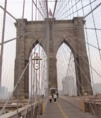
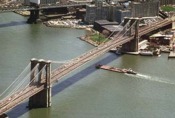
John Augustus Roebling (American, 1806-1869),
Brooklyn Bridge, 1869-1883, suspension
bridge with steel
cable, and stone masonry
piers. Completed by John's
son, Washington Augustus Roebling.
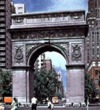
McKim, Mead & White, Washington Arch, 1889 / 91, marble, New York, NY. Inspired by Roman
triumphal arches, this structure was first erected as a temporary
structure made of wood and stucco
in 1889 to celebrate the centennial of George Washington's inauguration.
The design was rebuilt in marble in 1891. Decorated with sculptures
of Washington in both his civilian and military guises by Alexander
Stirling Calder (American, 1870-1945) and Herman MacNeil. In
the first decades of the 20th century, the West Village became
an increasingly bohemian
neighborhood, and the arch became a site of artistic and social
activism.
A masonry arch has a keystone surmounting and holding in place several wedge-shaped blocks, called voussoirs, that transmit the downward pressure laterally. A diaphragm arch is a transverse, wall-bearing arch that divides a vault or a ceiling into compartments, providing a kind of fire-break. Arches may take different shapes, as in the pointed Gothic arch, the rounded Roman or Romanesque arch, or the stilted Islamic arch, but all require support from other arches or buttresses.
Also see arcade, architecture, centering, fenestration, impost block, spandrel, springing, and thrust.
Other works in which arches are featured:
Francesco Guardi (Italian, 1712-1793), Triumphal Arch on the Embankment, Venice, pen and brown ink with brown wash, watercolor, heightened with white, 28 x 19.1 cm, Hermitage Museum, St. Petersburg, Russia.

https://inform.quest/_artHubert
Robert (French, 1733-1808), The Return of the Cattle, oil
on canvas, 80 3/4 x 48
inches (205.1 x 121.9 cm), Metropolitan Museum of Art, NY. See
Rococo.
![]()

John
Marin (American, 1870-1953), Brooklyn Bridge, c. 1912, watercolor and charcoal
on paper, 18 5/8 x 15 5/8 inches
(47.3 x 39.7 cm), Metropolitan Museum of Art, NY.

Around the world, McDonald's, an American fast-food restaurant
chain has used "golden arches" as the principle symbol
for its restaurants since the 1960s. See logo and signage.
Copyright © 1996-![]()